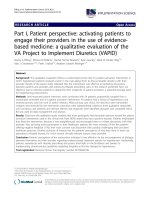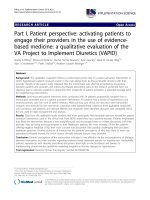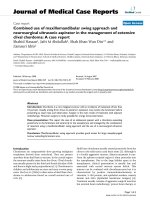UNDERSTANDING SOCIAL INTEGRATION PROCESSES IN THE USE OF ENTERPRISE SYSTEMS (ES) a SOCIAL CAPITAL PERSPECTIVE
Bạn đang xem bản rút gọn của tài liệu. Xem và tải ngay bản đầy đủ của tài liệu tại đây (1.07 MB, 256 trang )
UNDERSTANDING SOCIAL INTEGRATION
PROCESSES IN THE USE OF
ENTERPRISE SYSTEMS (ES):
A SOCIAL CAPITAL PERSPECTIVE
TEOH SAY YEN
(B.Bus.Com. (Hons.), Monash University
A THESIS SUBMITTED FOR THE DEGREE OF PH.D
IN THE FIELDS OF INFORMATION SYSTEMS
SCHOOL OF COMPUTING
DEPARTMENT OF INFORMATION SYSTEMS
NATIONAL UNIVERSITY OF SINGAPORE
2007
Acknowledgement
I would like to take this opportunity to express my heartfelt thanks to my supervisor,
Assistant Professor (Dr.) Pan Shan Ling, for his patience and efforts in guiding me
through this most challenging journey of four and a half years in fulfilling my
academic pursuits. In particular, I am grateful for his patient, meticulous instruction of
the methodology and understanding of the research process to me - from the
construction of a good quality research question, to the expression of one’s ideas and
finally, the analysis of the critical ideas so that a high-quality research paper may
ensue. Apart from sharing with me his philosophy on how to be an accomplished and
proficient academic, he has also fastidiously demonstrated and inculcated in me the
techniques and skills that I need to tackle research problems in my future endeavours.
Dr Pan’s involvement has indeed been highly instrumental to the completion of my
Ph.D. I am indebted to him, for without his encouragement, supervision and guidance
I would not be in this position that I am today.
To my beloved parents, Teoh Soon Kheng and Lee Chiu Yoon, I would like to
express my earnest thanks to them for providing me the psychological and emotional
support, in the most challenging times, by sharing their precious experiences and
listening to my complaints and frustrations. To my siblings, sister Teoh Say Hwa and
brother Teoh Tze Yang, I would also like to say thank you to them for preparing me
the delicious snacks, desserts, relaxing music and computer-related technical support
in times of need. Also, to my close companion, Joy, the cute little Shih Tzu, that
carries my stress away.
Special thanks to Mr. Chan Tet Eu, for granting access to the case company and
providing me with quality access to the company staff and information. Many thanks
to my best friends, Josephine Chong, Alice Yan, Wei-chang Kong, Shiuh-wei Yap,
Cai Shun, Liu Ming, and Chinn-miin Loke for providing the encouragement, care and
reassurance to me and walk through my difficult time hand-in-hand with me.
Last but not least, I would like to thank Department of Information Systems, National
University of Singapore for offering me the Ph.D research scholarship to realize my
dream.
i
Table of Contents
Table of Contents i
Abstract iv
List of Tables vi
List of Figures vii
Chapter 1: Introduction 1
Chapter 2: Literature Review 9
2.1 EVOLUTION OF ENTERPRISE SYSTEMS 9
2.1.1 Benefits of Enterprise Systems 11
2.1.2 Criticisms of Enterprise Systems 12
2.2 ENTERPRISE SYSTEMS-INDUCED CHANGE 14
2.3 ENTERPRISE SYSTEMS IMPLEMENTATION 16
2.3.1 Enterprise Systems Implementation Approaches 17
2.3.2 Enterprise Systems Life-Cycle 18
Phase I: Chartering Phase 20
Phase II: Project Phase 21
Phase III: Shakedown Phase 23
Phase IV: The Onward and Upward Phase 24
2.3.3 The Impact of Social Issues 25
2.4 SOCIAL CAPITAL 26
2.4.1 Social Capital Advantages 28
2.4.2 Social Capital Disadvantages 31
2.5 RELATIONSHIP OF SOCIAL CAPITAL AND SOCIAL INTEGRATION 33
2.5.1 Social Integration Conceptualization 34
2.5.1 Structural Dimension 35
Network Ties 35
Network Configuration 38
Appropriable Organization 39
2.5.2 Relational Dimension 40
Trust 40
Norms 42
Obligation, Expectation and Identification 43
2.5.3 Cognitive Dimension 44
Shared Language and Codes 45
Shared Narratives 46
2.6 SUMMARY 46
Chapter 3: Research Methodology 48
3.1 RESEARCH PHILOSOPHY 48
3.1.1 Philosophical Thoughts: Qualitative Research 49
3.1.2 Interpretive Case Study 50
3.2 RESEARCH STRATEGY: CASE STUDY 51
3.2.1 Single Case Study 53
3.2.2 Case Study Selection and Access: Talam Corporation Sdn. Bhd 53
3.3 DATA COLLECTION 54
Field Visits 54
Interview Questions 54
Archival Records and Examination of Documentations 55
Face-to-Face Interviews 55
Performing Direct Observations 58
Use of Multiple Languages and Dialogues 58
3.4 MODE OF ANALYSIS 58
Ten Methodological Principles for the Interpretive Process 61
The Circle of Understanding 62
Chapter 4: Case Study 64
4.1 CASE BACKGROUND 64
Organization Management Styles 64
Organization Physical Layout 66
IT Philosophy 68
Enterprise System Implementation 70
74
Use of ES: Sales and Marketing Module 78
Use of ES: Credit Control Module 88
Use of ES: Financial Module 94
Use of ES: Customer Service Action Module 106
Post-Enterprise System Maintenance 113
Benefits of Post-Enterprise System Alterations 116
Upgrading of Customer Service System 118
Chapter 5: Findings and Analysis 127
5.1 INTRODUCTION 127
5.2 SOCIAL INTEGRATION DIMENSIONS 128
Structural Integration Dimension (D1) 128
Relational Reformation Dimension (D2) 133
Cognitive Construction Dimension (D3) 137
Summary 140
5.3 THE SIX SOCIAL INTEGRATION PROCESSES 143
5.3.1 Coordinating Employees with a Set of Clearly Assigned Tasks (Process 1) 143
5.3.2 Cultivating Consistent Organizational Practices (Process 2) 149
5.3.3 Achieving Interactive Interpretations (Process 3) 154
5.3.4. Using System Mediated Terms (Process 4) 159
5.3.5. Fostering Internal Bonding (Process 5) 163
5.3.6. Establishing External Bridging (Process 6) 169
5.4 SUMMARY FOR MAJOR RESEARCH FINDINGS 175
Chapter 6: Conclusion 177
6.1 THEORETICAL CONTRIBUTION AND IMPLICATIONS 178
6.2 MANAGERIAL CONTRIBUTIONS AND IMPLICATIONS 181
6.3 LIMITATION AND FUTURE RESEARCH 184
References: 186
APPENDIX A: COPYRIGHT OWNERSHIP 207
APPENDIX 1: TOTAL ATTEMPT AND FAILURE RECORD FROM MALAYSIA ORGANIZATIONS 208
APPENDIX 2: TOTAL ATTEMPT AND FAILURE RECORD FROM SINGAPORE ORGANIZATIONS 210
APPENDIX 3: A PROPOSAL OF CASE STUDY AT TALAM CORP BHD., MALAYSIA 212
APPENDIX 4: LIST OF INTERVIEW QUESTIONS: PRIOR COMPANY VISIT 216
APPENDIX 5: SAMPLE OF INTERVIEW QUESTIONS: 4
TH
VISIT 219
APPENDIX 6: EXAMPLE OF AGENDA AND UP COMING MEETING 222
APPENDIX 7: TALAM CORPORATION BERHAD HISTORY, FUTURE DEVELOPMENT, MISSION AND GOAL
225
APPENDIX 8A: TALAM CORPORATION ANNUAL REPORT 2003 SAMPLE 228
APPENDIX 8B: TALAM CORPORATION ANNUAL REPORT 2004 SAMPLE 229
229
APPENDIX 9: INTERVIEWEES’ BACKGROUND AND ROLE 230
APPENDIX 10: DATA COLLECTED FROM TALAM CORPORATION 232
APPENDIX 11: PRESS RELEASE- TALAM DESERVES A SECOND LOOK NOW 234
(THE STAR ONLINE, TUESDAY AUGUST 10, 2004) 234
APPENDIX 12: SAMPLE OF PUBLICITY LEAFLETS 237
237
APPENDIX 13: SAMPLE OF IFCA PROPERTY SOLUTION 238
238
APPENDIX 14: SAMPLE OF ORGANIZATION CHARTS AND POLICIES 239
APPENDIX 15: EXAMPLE OF TALAM CORPORATION: INFORMATION TECHNOLOGY DEPARTMENT
OBJECTIVES 241
APPENDIX 16: EXAMPLE OF THE STANDARD INSTRUCTIONS AND STANDARD OPERATION
PROCEDURES (SOP) FOR THE INFORMATION TECHNOLOGY TALAM CORPORATION BERHAD 243
APPENDIX 17: TALAM CORPORATION CUSTOMER SERVICE CENTER- COMPLAINT FORM 244
APPENDIX 18: METHOD OF DATA ARRANGEMENT 245
Abstract
Among recent enterprise systems (ES) researches, many have examined ES
implementation issues, but very few have explored issues related to ES use. The
insufficient research at post-ES implementation has become the new research
concern. Expending from this inadequacy, this thesis examines post-ES
implementation issues, in particular, the use of ES in supporting organizational daily
operations from a social capital (SC) perspective. The research interest is to
understand the concept of social integration (SI) through exploring the use of ES in
supporting daily operations of the organizations. To better understand the relationship
of ES users’ interests, behavior and attitudes in the social and organizational context,
an interpretive case study was conducted with Talam Corporation. Talam has a ten-
year experience in managing and using ES to facilitate its daily operations and
business dealings. Discussions data were compiled following five periodical visits
spread across March 2004 to May 2005 with ES users from all levels. A coherent
conceptual social integration (SI) framework is derived from data collected. Six SI
processes formed from three SI dimensions, which have linked the three SC
dimensions, were found to analyze the activities taking place among employees from
a systematic perspective and explaining the interrelationship of dynamic social capital
in an organization. Thus deliberate investment in SI could be the foundation for
potential organizational advantage. Based on this premise, it is critical for ES
practitioners to focus on these five main areas: (1) understanding organization’s
external and internal environment status so as to continue planning for ES
enhancement, (2) applying a suitable management style to better manage and connect
ES users according to the organizational ES structure, (3) providing the flexibility in
using multiple communication channels to transfer messages, information and
knowledge among the ES users, (4) allowing ES users to expand and formulate their
networks without much interference, and (5) paying appropriate attention to identify,
manage and facilitate social relation in ES use which would bring value to
organizations, as they become strategic capital and a source of competitive advantage.
vi
List of Tables
Table 2. 1: Enterprise systems based business conduct (Adopted from Daniels, 1993) 14
Table 2. 2: A brief summary of social capital benefits (Prusak and Cohen, 2001, p. 10) 31
Table 2. 3: Main concepts of different social network ties 36
Table 2. 4: Dimensions and components of trust (Chun and Bontis, 2002, p. 27) 41
Table 3. 1: List of interviews 57
Table 3. 2: Total number of other interviews and observations 57
Table 3. 3: Seven principles of interpretive studies (Adapted from Klein and Myers, 1999) .60
Table 3. 4: Ten methodological principles for the interpretive principles of the hermeneutic
(Butler, 1998, p. 292) 61
Table 3. 5: The circle of understanding as applied in the case (Adapted from Butler, 1998, p.
296) 62
Table 4. 1 Different levels of management styles 66
Table 4. 2: Managing ES use 98
Table 4. 3: IT staff working experience and obligations 113
Table 4. 4: Systems alteration projects from year 2001 to 2004 118
Table 5. 1: Summary of the major research findings 175
List of Figures
Figure 2. 1: Alternative implementation approaches (Davenport, 2000b, p. 14) 17
Figure 2. 2: Enterprise system experience cycle (Markus and Tanis, 2000, p. 189) 19
Figure 3. 1: Underlying philosophical assumptions (Myers, 1997) 49
Figure 4. 1: Floor plan for all departments 67
Figure 4. 2: The chronology ES development in Talam 73
Figure 4. 3: Use of ES in Talam's daily operations 74
Figure 4. 4: Functional structure of the Finance department 95
Figure 5. 1: Social integration framework 142
Figure 5. 2: The process involved to connecting structural and relational dimensions in
achieving structural integration (Scenario 1 & 2) 144
Figure 5. 3: The process involved to connecting structural and relational dimensions in
achieving structural integration (Scenario 3 & 4) 146
Figure 5. 4: The process involved to connecting structural and relational dimensions in
achieving structural integration (Scenario 1) 149
Figure 5. 5: The process involved to connecting structural and relational dimensions in
achieving structural integration (Scenario 2, 3, 4 & 5) 150
Figure 5. 6: The process involved to connecting relational and cognitive dimensions in
achieving relational integration (Scenario 1) 155
Figure 5. 7: The process involved to connecting relational and cognitive dimensions in
achieving relational integration (Scenario 2, 3 & 4) 156
Figure 5. 8: The process involved to connecting relational and cognitive dimensions in
achieving relational integration (Scenario 1 & 2) 159
Figure 5. 9: The process involved to connecting relational and cognitive dimensions in
achieving relational integration (Scenario 3) 162
Figure 5. 10: The process involved to connecting relational and structural dimensions in
achieving structural integration (Scenario 1, 2 & 3) 164
Figure 5. 11: The process involved to connecting relational and structural dimensions in
achieving structural integration (Scenario 1) 169
Figure 5. 12: The process involved to connecting relational and structural dimensions in
achieving structural integration (Scenario 2) 171
Figure 5. 13: The process involved to connecting relational and structural dimensions in
achieving structural integration (Scenario 3) 173
1
Chapter 1: Introduction
In today’s fast changing environment, all organizations face the challenge of
achieving sustained profitable growth. To sustain competency and competitiveness,
organizations have made significant investment in information technologies (IT). IT is
recognized as a viable method to enhance organizational competitiveness (Markus
and Banjamin, 1997). Despite the fact that IT has significantly supported daily
business organizational operations, this stand-alone system or fragmented system is
soon found to be incapable of supporting organizations to compete in the increased
competitiveness in the business environment. This insufficiency has sparked off the
need for integrated systems in organizations. Eventually in the 1990s, enterprise
system (ES), an integrated system was developed (Markus and Tanis, 2000).
ES is known as a comprehensive system that links software across departments,
business functions and geographical boundaries for information to flow seamlessly
(Davenport, 2000a). Specifically, this system mainly integrates all enterprise
processes together, namely: sales and order management, purchasing, financial and
accounting, and human resource management (Kumar and Hillegersberg, 2000). Such
a system is known as the most important invention in the corporate use of IT
(Davenport, 2000a). It is the first ever information integrated system (Davenport,
2000b) that serves managers with organizations’ most strategic computing platform
(Hong and Kim, 2002).
In today’s fast-changing and highly competitive environments, this groundbreaking
ES is designed not only to solve information fragmentation (Davenport and Prusak,
1998) but also to improve organizations standard to achieve profitable growth.
2
Organizational performances are improved through streamlining work flow to
increase productivity, reduce expenses, and improve decision-making quality and
resource control (Howcroft, et al., 2004). Besides, this system could offer the most
effective ways for the organization to conduct information tracing activity (Rizzi and
Zamboni, 1999); provide companies with direct real-time information access with a
few clicks of the mouse (Davenport and Prusak, 1998; Brown and Vessey, 2003).
Therefore, Davenport and Prusak (1998) claimed that ES could possibly assist the
organization to both gain in productivity and speed and also improve intra-
organizational performance relationships which leads to inter-organizational
transformation and subsequently empire business alliances in the near future
(Davenport, 2000b).
In view of its strengths, ideally, a successful ES implementation can save millions of
dollars in organizational expenses in the long-term. This is because it can reduce cost,
improve production cycles, generate more accurate demand forecasts, and enhance
customer services (Umble, et al., 2003). To ensure organizational competency and
competitiveness, organizations are making significant investments in ES, in the belief
that ES can save millions of dollars in organizational expenses. Due to the irresistible
benefits offered by ES, many organizations have jumped onto the ES bandwagon
without proper planning and considerations. Such an action has resulted in as high as
90% of organizations failing to implement ES efficiently (Martin, 1998). This study
finds that it is most important for organizations to critically consider, understand and
plan before implementing ES. Besides knowing ES benefits, organizations must also
consider ES technical and business challenges (Davenport, 2000b). The technical
challenge of ES as a standard package has complicated its business challenge. The
3
rigid technical software package not only limits the flexibility of the organizations
(Umble, et al., 2003), but it can even jeopardize core operations (Hong and Kim,
2002), and at worst, force companies to change business practices such as company
strategy, and culture (Kawalek and Wood-Harper, 2002; Yakovlev, 2002; Umble, et
al., 2003) to align with the new system (Yakovlev, 2002). The complex nature of ES
emphasizing system integration across departments has indirectly stirred up tension
between intra and inter-department employees as Soh, et al.’s (2000) claimed. Thus,
Volkoff (1999) pointed out that implementing ES will cause disruptive organizational
change and lead to organizations losing their competitive edge (Davenport and
Prusak, 1998). In view of this, it is advisable for organizations to think twice before
investing in ES (Umble, et al., 2003), as so far, only 10 % of the organizations with
proper planning have succeeded in ES implementation (Martin, 1998) but they are yet
to enjoy the benefits of ES. Learning through experience, practitioners and academics
have come to realize that obtaining ES benefits is not as straightforward as they
initially believed it to be (Howcroft, et al., 2004).
Many previous researches have looked at the ES implementation process, but very
few have actually studied post-ES implementation. To be specific, most previous
studies focused on the development of stage model which illustrated that sequential
implementation activities are useful for the planning of future actions but neglected to
explore the inter-related issues that have contributed to process effectiveness. In
addition, previous studies also suggested that the quality of post-ES implementation
would heavily depend on the quality of the implementation process (Nicolaou, 2004).
Such review has clearly shown that insufficient research at post-ES implementation
has become the new research concern (Lorenzo, 2001). Though there is study done by
4
Nicolaou (2004) to examine the process of system review during the post-ES
implementation and it identifies key elements that contribute to the high-quality of
post implementation, there is still fairly little research that explored the key elements
influencing the use of ES.
To explore the key elements influencing the use of ES, this study begins its research
anchored in the existing ES implementation literature. This is because the impact and
outcome of an ES depend upon the unique context of implementation (Scott, 2000). In
reviewing the existing literature of ES implementation, human-related issues have
been identified as one of the main reasons causing the failure of ES implementation
and this issue has persisted until today (e.g. Lorenzo, 2001; Ragowsky and Somer,
2002; Newell, et al., 2002). This organizational mode of behaviour can vary from
stakeholders seeing the ES as a rational system that will maximize the efficiency and
effectiveness of the organization through to stakeholders seeing the ES from a private
self-interested perspective (Watt, et al., 2005). In one recent finding, Ragowsky and
Somers (2002) suggested that the benefits of ES are dependent on problems related to
people and culture, and not on technically related ones. Considering these reviews,
this study argues that human or social issue would continue to be a challenge even in
the use of ES after implementation (post implementation).
To compete in today’s highly competitive markets, organizations do not only need to
rely on useful and suitable technologies, but more importantly, they must be able to
manage their social issues well. Every organization is founded from a social
community where individuals are hired and gathered to transform their knowledge
and expertise into economically useful products and services (Kogut and Zander,
5
1992). To maximize its advantage, an organization would depend highly on the
network of relationships possessed by individuals to create and share knowledge
(Nahapiet and Ghoshal, 1998). The strategic use of social networks and relationships
by individuals to make sense of the new organizational processes through overcoming
the challenge of ES’s complex nature (e.g. the tension between the intra and inter-
department employees) (Soh, et al., 2000) is known as drawing upon individuals’
collective social capital (SC).
One of the earliest SC studies can be traced back to 1965 (Jacobs, 1965). This SC
study was then discussed in the work of economist Loury (1997, 1981), and in
contemporary sociological discourse (Bourdieu, 1985). Loury (1977, 1981) and
Bourdieu’s (1985) works paved the way for further studies leading to Coleman’s
(1988) more-refined SC analysis (Portes, 1998). However, the rather vague SC
definition (Portes, 1998) has opened the door for more subsequent research. Hence, a
number of theoretical analyses of social capital (e.g. Baker, 1990; Schiff, M., 1992;
Burt, 1992; et al.) have been published in the realms of political science, sociology,
and economic developments (Lesser, 2000) and SC terminology has been widely used
by different researchers (Hirsh and Levin, 1999).
Study acknowledges that social capital may not be the only key to achieving success
in an organization (Cohen and Prusak, 2001), but it has a significant impact on
creating and sharing knowledge (Tsai and Ghoshal, 1998) on top of intellectual
capital (Nahapiet and Ghoshal, 1998). It can also facilitate inter-unit resource
exchange contributing to product innovations (Hansen, 1999; Tsai and Ghoshal, 1998)
as well as cross-functional team effectiveness (Rosenthal, 1996). Thus, deliberate
6
investment in social capital can help organizations firstly, to identify and elaborate the
significance of knowledge processes as the foundation of organizational advantage
(Nahapiet and Ghoshal, 1998) and, secondly, to encounter challenges and even turn
them to advantages (Cohen and Prusak, 2001).
SC is widely used by many researchers but among previous studies, there is a lack of
consensus on a precise definition of social capital (Nahapiet and Ghoshal, 1998). In
order to better understand the social interactions between ES users, Nahapiet and
Ghoshal’s (1998) definition of social capital is adopted in this research. This is
because Nahapiet and Ghoshal’s (1998) definition has taken into account both the
network and the resources (assets) that may be mobilized through that network
(Bourdieu, 1985; Burt, 1992), and the researchers believe that it can provide a clearer
and more extensive explanation on the use of ES in achieving organizational
advantage. SC is therefore, defined as “the sum of the actual and potential resources
embedded within, available through, and derived from the network of relationships
possessed by an individual or a social unit” (Nahapiet and Ghoshal, 1998, p. 243).
With this definition they further developed a useful framework for understanding
social capital by dividing the concept into three dimensions: structural, cognitive and
relational. However, notwithstanding their substantial insights of social capital,
Nahapiet and Ghoshal (1998) claimed that the SC framework still lacks a coherent
theory to integrate the interrelationships among the three social capital dimensions,
and this is an important focus for this research.
Many studies of SC did implicitly explain the interrelationships between the SC
factors but very little research has explicitly studied the interrelationships of SC. In
7
view of this rather incoherent theory of SC, in particular on SC integration, this study
will draw on Nahapiet and Ghoshal’s (1998) SC as a guide to understand social
integration issues with regards to social concerns in the application of ES. Since social
issues have been highlighted as critical in comparison with technical issues in ES (e.g.
Lorenzo, 2001; Ragowsky and Somers, 2002), the research believes that by studying
social integration (SI) - the processes that bring about the integration of the three
social capital dimensions (structural, relational and cognitive) as stated by Nahapiet
and Ghoshal (1998), can provide a better understanding and explanation of the
challenges faced by the ES users. In a nutshell, the purpose of this research is to
understand social integration in ES use by exploring its dimensions and processes.
The research question is: what and how are the social integration processes and
dimensions inter-related in the use of ES?
The contributions of this study are discovering and explaining the influence of SI
processes and dimensions as well as providing a better understanding of SI in ES
usage for practitioners. Specifically, the result of the social integration conceptual
framework successfully presented a coherent, systematic view and illustrated the
interrelationships of dynamic social capital. In the process, the six SI processes
formed from the three SI dimensions were found to analyze the activities taking place
among employees from a systematic perspective and explaining the interrelationship
of dynamic social capital in an organization. Accordingly deliberate investment in SI
could be the foundation for potential organizational advantage. Based on this premise,
it is critical for ES practitioners to focus on these five main areas: (1) understanding
organization’s external and internal environment status so as to continue planning for
ES enhancement, (2) applying a suitable management style to better manage and
8
connect ES users according to the organizational ES structure, (3) providing the
flexibility in using multiple communication channels to transfer messages,
information and knowledge among the ES users, (4) allowing ES users to expand and
formulate their networks without much interference, and (5) paying appropriate
attention to identify, manage and facilitate social relation in ES use which would
bring value to organizations, as they become strategic capital and a source of
competitive advantage.
The thesis is organized as follows. After the introduction, Chapter 2 begins with a
literature review of ES phenomenon and SC theory. Chapter 3 presents the
methodology used in examining and exploring the research interest of this thesis.
While Chapter 4 illustrates and describes the case study- Talam, Chapter 5 highlights
the findings from the case study, and conceptualizes the social integration framework
with the collected data. Chapter 6 confers the theoretical and managerial implications
and conclusions of this research.
9
Chapter 2: Literature Review
This section is aimed at having an in-depth review of existing enterprise systems and
social capital literature in order to highlight issues and challenges in the chosen areas
of investigation. The main body of literature review is organized as follows: evolution
of ES, its benefits, criticisms, ES-induced change, ES implementation approaches and
ES life-cycles. Next, a thorough review of SC is carried out before the major
components of the theory are outlined and research questions delineated.
The rational in dividing the literature review into this structure is to be familiar with
ES by going through its evolution, benefits, criticisms and the issues brought along by
the ES-induced changes. The study then proceeds to review ES implementation
issues, approaches and life-cycles in order to have a thorough knowledge of the ES
phenomena. A comprehensive review of the understanding of SC will be done before
drafting the major components of the theory which this study is aiming to explore.
2.1 Evolution of Enterprise Systems
Prior to the existence of ES, the information technology-induced change in
organizations has been an ongoing issue in the information systems literature for more
than half a century (Robey and Boudreau, 1999). At that juncture, IT was recognized
as a viable method to enhance organizational competitiveness; however, the often-
touted benefits from ES are not as straight-forward as vendors suggested (Wagner, et
al., 2005); therefore, its business value still remains unclear (Markus and Benjamin,
1997; Rockart and Short, 1989; Robey and Boudreau, 1999).
10
Today, the claims that ES offer attractive benefits for organizations are again doubtful
to most researchers and practitioners. According to a recent research, Hitt, et al.,
(2002) claimed that based on their collected short-term post implementation data, they
find that ES organizations tend to show higher performance across a wide variety of
financial matrices but there is a slowdown sign in business performance and
productivity after the implementation. Nonetheless, even with the slow performance
after the ES implementation, financial markets still have confidence with these ES
organizations and consistently reward those ES adopters with higher market valuation
(Hitt, et al., 2002). Thus, until now the utilization of ES among organizational
members often remains at a perfunctory level (Lim, et al., 2005). The actual long-term
business values that are supposed to be delivered by the ES are yet to be explored
(Hitt, et al., 2002). To appreciate the ES phenomena, it is essential to establish a
sufficient spectrum of knowledge regarding this phenomenon.
In the past, although organizations had fulfilled their information needs by adopting
IT through developing disparate systems, those systems were loosely integrated
throughout IT departments. Recognizing the weaknesses in the fragmented systems
together with the increased competitiveness in the business environment,
organizations were prone to consider IT-enabled integration (Rockart and Sbort,
1989). Finally in the 1990s, an integrated software package, Enterprise Resource
Planning (ERP) system, was developed (Markus and Tanis, 2000). This process of
evolution started from the internal standard inventory control (IC) packages, material
requirements planning I and II (MRP I and II) to other enterprise processes such as
sales and order management, purchasing, financial and accounting, and human
resource management (Kumar and Hillegersberg, 2000). Being variously called ERP,
11
enterprise systems (ES) or enterprise-wide systems (Ragowsky and Somers, 2002),
ES is integrated sets of software modules (Markus and Tanis, 2000) linked to a
common database in which it is able to handle basic corporate functions like finance,
human resources, materials management (Kumar and Hillegersberg, 2000; Slater,
1998), as well as a facilitator of other ES initiatives (Pan and Tan, 2005) such as
material requirement planning with a Just In Time (JIT) material management
procedure at the assembly lines (Boersma and Kingma, 2005).
2.1.1 Benefits of Enterprise Systems
Nowadays, ES are viewed as the most important development in the corporate use of
IT (Davenport and Prusak, 1998). For the first time, this is the first system that
possessed the character to integrate all information flow seamlessly across business
functions, units, and geographical boundaries (Davenport, 2000b). These systems do
not only solve the information fragmentation problem (Davenport and Prusak, 1998),
but can also be considered as one of the most effective ways for organizations to
conduct information tracing activity (Rizzi and Zamboni, 1999). More importantly, a
successful ES project can save a company millions of dollars in the long run as it can
reduce operating costs, improve production cycles, generate more accurate demand
forecasts, and greatly enhance customer service (Umble, Haft, and Umble, 2003).
Another benefit of ES is that it provides organizations with direct access to a wealth
of real-time operating information (Davenport and Prusak, 1998, Brown and Vessey,
2003). Now, all transactions including every piece of company operations and
performance information are performed with just a few clicks of the mouse
(Davenport, 2000b, Brown and Vessey, 2003). This has contributed to more efficient
12
relationships of intra-organization performance and is also projected to lead the inter-
organization transformation and empires of business alliances in the near future
(Davenport, 2000b).
These benefits can be translated into dramatic gains in productivity and speed for
organizations (Davenport and Prusak, 1998). Thus, potential business benefits, in
terms of economic, technical and social may indeed be significant once an
organization completes its renewal of enterprise IT infrastructure (Markus and Tanis,
2000). Unfortunately, in reality, only a few organizations are able to enjoy the
potential benefits of ES (Parr and Shanks, 2000). For this reason, a better
understanding of the ES is important. But, prior to that, let’s look at some of the user-
application criticisms of ES.
2.1.2 Criticisms of Enterprise Systems
In general, the notion of best practices is illusory (Swan, et al., 2000). ES can have an
impact on the organization’s business processes, structure, culture and enterprise level
performance, as well as individual employees’ motivation, job specification and
performance (Markus, 2004) that may influence the degree of “fit” between particular
design philosophies and prevailing organizational contexts in different countries
(Swan, et al., 2000). However, the most commonly known ES downsides are the
technical and business perspectives (Davenport, 2000b). In terms of technical
perspective, ES have changed the conventional style of IT from an artifact that may
be tailored to different needs, to a standard package. Consequently, conventional IT
problems, such as, up-front requirements, design activity, political and socio-technical
requirements have also changed (Kawalek and Wood-Haper, 2002).
13
ES are designed to fit the needs and interests of organizations (Davenport and Prusak,
1998; Markus and Tanis, 2000). According to researchers, ES or the so called “best
practices” are built to support generic business processes that may differ quite
substantially from the way any particular organization does business (Markus and
Tanis, 2000). Unfortunately, this standard package or “best practices” is too rigid
(Davenport, 2000b); its proprietary systems are opposed to open system architectures
where they limit the flexibility of the enterprise; (Umble, et al., 2003) thus, forcing
companies to change their existing business practices, namely, company strategy and
culture (Kawalek and Wood-Harper, 2002; Yakovlev, 2002; Umble, et al., 2003) in
order to fit into the new systems (Yakovlev, 2002). Such requirement is described as
disruptive organization changes by Volkoff (1999) and has caused many
organizations to lose their competitive advantages after the change (Davenport and
Prusak, 1998).
Research claims that most ES implementation periods have to be extended,
considering the high implementation cost ranging from USD$300,000 to several
hundred million dollars, depending on the size of the organization (Heizer and
Render, 2003). Most of the extended time is found wasted on the changing business
processes rather than the system installation (Davenport, 2000b). Besides, issue such
as misalignments between system and organization is commonly identified late in
implementation (Soh and Sia, 2005). In spite of the fact that many ES vendors still
argue that these “best practices” suit most organizations (Bailey, 1999), such system
should be viewed as mandatory technology (Chae and Poole, 2005). Despite that,
studies have also found that organizations would have to spend a high cost to secure
the benefits of ES (Stein, 1999). Considering these setbacks, it is important for
14
organizations to think twice about the actual needs of the organization (Umble, et al.,
2003) before jumping onto the ES bandwagon.
To better understand the ES phenomena, the study of ES can be separated into two
different studies: (1) the macro-level analysis focuses on higher level of investigation
such as, the use of ES in organizations and how it is linked with complex sets of
market and power relations (Howcroft and Truex, 2001); (2) the micro-level analysis
examines closely on issues such as, user participation during the ES implementation,
the effect of ES towards organizational control and power distribution, and software
selection and requirements analysis process (Howcroft and Truex, 2002). The
subsequent section provides a brief overview of ES’s macro-level analysis by
showing the use of ES in organizations and the changes made in them before pursuing
the micro-level analysis examination which is the focus of this research.
2.2 Enterprise Systems-induced Change
This integrated systems-ES have tremendously changed the organizational business
orientation. The following table briefly introduces the usefulness of ES in the highly
competitive environment and also points out the differences between IT- and ES-
oriented businesses.
Core
Organization
Factors
Information Technology
oriented Business
(19
th
Century)
Enterprise Systems
oriented Business
(20
th
to 21
st
Century)
Business Centric Strategic Centric
Purpose
Long-term Focus Short and Long-term Focus
“Any Actual Place” “Virtual Place” Structure
Holistic Approach Organic Approach
Cross-functional
Boundaries
Boundaryless
People
Process
Cross-level Communication Cross-level Communication
Table 2. 1: Enterprise systems based business conduct (Adopted from Daniels, 1993)
15
The arrival of knowledge economy is driven by the rapid technological advancement
(Cowey, 2000). This emergence of knowledge-based economy places great
importance on the diffusion and use of information, knowledge and creation rather
than IT in the previous global economy. Pressures from the external environments
force organizations to change their organizational purpose from business to strategic
centric. To survive in the hypercompetitive business environments, nowadays,
organizations are continually engaged in a process of renewing their market strategies
and production lines (Dougherty, 1992; Teece, et al., 1997). Those companies that are
weak in strategic planning usually are unable to control and coordinate their
worldwide operations (Hanseth, et al., 2000). Therefore, being strategic centric is
critical as it emphasizes focus of the organization’s ambitious goals, and requires
analysis on the company’s resources to identify its strengths and weaknesses (Hill and
Jones, 2001). With the integrated applications and databases, process and supply-
chain integration, ES have added capability to the businesses for “stretching” the
competitive and strategic agenda (Al-Mashari, et al., 2003). In other words, ES enable
organizations to perform strategic centric with better short and long-term focuses.
Nowadays, organizations function like a living organism than a machine; therefore,
the organic approach enforces more flexible structures that are more malleable to
changing external conditions (Robey, 1991) rather than employing the holistic
approach that adopts a totally opposite concept (Daniels, 1993). In addition, with the
integrated ES, now, managers may access information needed at any place and time
(Devanport, 2000 b). In other words, managers from different parts of the world may
gather and meet at any “virtual place”, which enables the making of more timely
decisions rather than require meeting at “any actual place” which requires high









